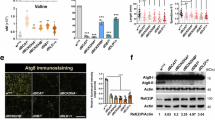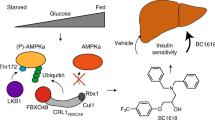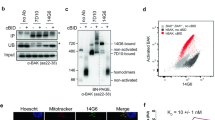Abstract
The traditional Chinese medicine “Fuzi” (Aconiti Lateralis Radix Praeparata) and its three representative alkaloids, aconitine (AC), benzoylaconine (BAC), and aconine, have been shown to increase mitochondrial mass. Whether Fuzi has effect on mitochondrial biogenesis and the underlying mechanisms remain unclear. In the present study, we focused on the effect of BAC on mitochondrial biogenesis and the underlying mechanisms. We demonstrated that Fuzi extract and its three components AC, BAC, and aconine at a concentration of 50 μM significantly increased mitochondrial mass in HepG2 cells. BAC (25, 50, 75 μM) dose-dependently promoted mitochondrial mass, mtDNA copy number, cellular ATP production, and the expression of proteins related to the oxidative phosphorylation (OXPHOS) complexes in HepG2 cells. Moreover, BAC dose-dependently increased the expression of proteins involved in AMPK signaling cascade; blocking AMPK signaling abolished BAC-induced mitochondrial biogenesis. We further revealed that BAC treatment increased the cell viability but not the cell proliferation in HepG2 cells. These in vitro results were verified in mice treated with BAC (10 mg/kg per day, ip) for 7 days. We showed that BAC administration increased oxygen consumption rate in mice, but had no significant effect on intrascapular temperature. Meanwhile, BAC administration increased mtDNA copy number and OXPHOS-related protein expression and activated AMPK signaling in the heart, liver, and muscle. These results suggest that BAC induces mitochondrial biogenesis in mice through activating AMPK signaling cascade. BAC may have the potential to be developed as a novel remedy for some diseases associated with mitochondrial dysfunction.
Similar content being viewed by others
Log in or create a free account to read this content
Gain free access to this article, as well as selected content from this journal and more on nature.com
or
References
Zhao D, Wang J, Cui Y, Wu X. Pharmacological effects of Chinese herb aconite (fuzi) on cardiovascular system. J Tradit Chin Med. 2012;32:308–13.
Wang Q, Kuang H, Su Y, Sun Y, Feng J, Guo R, et al. Naturally derived anti-inflammatory compounds from Chinese medicinal plants. J Ethnopharmacol. 2013;146:9–39.
Liou SS, Liu IM, Mei CL, Cheng JT. Comparison of the antinociceptive action of crude Fuzi, the root of Aconitum, and its processed products. J Ethnopharmacol. 2005;99:379–83.
Du J, Lu X, Long Z, Zhang Z, Zhu X, Yang Y, et al. In vitro and in vivo anticancer activity of aconitine on melanoma cell line B16. Molecules. 2013;18:757–67.
Zhao C, Li M, Luo Y, Wu W. Isolation and structural characterization of an immunostimulating polysaccharide from fuzi, Aconitum carmichaeli. Carbohydr Res. 2006;341:485–91.
Tan G, Liao W, Dong X, Yang G, Zhu Z, Li W, et al. Metabonomic profiles delineate the effect of traditional Chinese medicine Sini decoction on myocardial infarction in rats. PLoS ONE. 2012;7:e34157.
Liu J, Li Q, Yin Y, Liu R, Xu H, Bi K. Ultra-fast LC-ESI-MS/MS method for the simultaneous determination of six highly toxic Aconitum alkaloids from Aconiti kusnezoffii radix in rat plasma and its application to a pharmacokinetic study. J Sep Sci. 2014;37:171–8.
Singhuber J, Zhu M, Prinz S, Kopp B. Aconitum in traditional Chinese medicine-a valuable drug or an unpredictable risk? J Ethnopharmacol. 2009;126:18–30.
Wada K, Nihira M, Hayakawa H, Tomita Y, Hayashida M, Ohno Y. Effects of long-term administrations of aconitine on electrocardiogram and tissue concentrations of aconitine and its metabolites in mice. Forensic Sci Int. 2005;148:21–9.
Bisset NG. Arrow poisons in China. Part II. Aconitum--botany, chemistry, and pharmacology. J Ethnopharmacol. 1981;4:247–336.
Huang L, Peng S, Zhang S, Hu Q, Yu R, Liu H, et al. Hepatic energy metabolism on rats by six traditional Chinese medicine with hot property. Zhongguo Zhong Yao Za Zhi. 2010;35:1470–3.
Yu HY, Wang SJ, Teng JL, Ji XM, Wu ZC, Ma QC, et al. Effects of Radix aconiti lateralis preparata and Rhizoma zingiberis on energy metabolism and expression of the genes related to metabolism in rats. Chin J Integr Med. 2012;18:23–9.
Lu X, Zhang L, Li P, Wang J, Li R, Huang Y, et al. The protective effects of compatibility of Aconiti Lateralis Radix Praeparata and Zingiberis Rhizoma on rats with heart failure by enhancing mitochondrial biogenesis via Sirt1/PGC-1α pathway. Biomed Pharmacother. 2017;92:651–60.
Park G, Kim KM, Choi S, Oh DS. Aconitum carmichaelii protects against acetaminophen-induced hepatotoxicity via B-cell lymphoma-2 protein-mediated inhibition of mitochondrial dysfunction. Environ Toxicol Pharmacol. 2016;42:218–25.
Wu J, Lin N, Li F, Zhang G, He S, Zhu Y, et al. Induction of P-glycoprotein expression and activity by Aconitum alkaloids: Implication for clinical drug-drug interactions. Sci Rep 2016;6:25343.
Wang L, Mascher H, Psilander N, Blomstrand E, Sahlin K. Resistance exercise enhances the molecular signaling of mitochondrial biogenesis induced by endurance exercise in human skeletal muscle. J Appl Physiol. 2011;111:1335–44.
Piao Y, Kim HG, Oh MS, Pak YK. Overexpression of TFAM, NRF-1 and myr-AKT protects the MPP( + )-induced mitochondrial dysfunctions in neuronal cells. Biochim Biophys Acta. 2012;1820:577–85.
Zamora M, Pardo R, Villena JA. Pharmacological induction of mitochondrial biogenesis as a therapeutic strategy for the treatment of type 2 diabetes. Biochem Pharmacol. 2015;98:16–28.
Ren J, Pulakat L, Whaley-Connell A, Sowers JR. Mitochondrial biogenesis in the metabolic syndrome and cardiovascular disease. J Mol Med. 2010;88:993–1001.
Wu Z, Puigserver P, Andersson U, Zhang C, Adelmant G, Mootha V, et al. Mechanisms controlling mitochondrial biogenesis and respiration through the thermogenic coactivator PGC-1. Cell. 1999;98:115–24.
Irrcher I, Adhihetty PJ, Sheehan T, Joseph A-M, Hood DA. PPARgamma coactivator-1alpha expression during thyroid hormone- and contractile activity-induced mitochondrial adaptations. Am J Physiol Cell Physiol. 2003;284:C1669–77.
McGee SL, Hargreaves M. AMPK and transcriptional regulation. Front Biosci. 2008;13:3022–33.
Picca A, Lezza AMS. Regulation of mitochondrial biogenesis through TFAM-mitochondrial DNA interactions: Useful insights from aging and calorie restriction studies. Mitochondrion. 2015;25:67–75.
Jager S, Handschin C, St-Pierre J, Spiegelman BM. AMP-activated protein kinase (AMPK) action in skeletal muscle via direct phosphorylation of PGC-1alpha. Proc Natl Acad Sci USA. 2007;104:12017–22.
Hardie DG, Sakamoto K. AMPK: a key sensor of fuel and energy status in skeletal muscle. Physiol (Bethesda). 2006;21:48–60.
Liu J, Rao M. A simple method for measuring oxygen consumption in mice. Chin J Pathophysiol. 1996;12:105–7.
Stock MJ. An automatic, closed-circuit oxygen consumption apparatus for small animals. J Appl Physiol. 1975;39:849–50.
Zhu J, Wang KZQ, Chu CT. After the banquet: mitochondrial biogenesis, mitophagy, and cell survival. Autophagy. 2013;9:1663–76.
Nisoli E, Clementi E, Moncada S, Carruba MO. Mitochondrial biogenesis as a cellular signaling framework. Biochem Pharmacol. 2004;67:1–15.
Polster BM, Fiskum G. Mitochondrial mechanisms of neural cell apoptosis. J Neurochem. 2004;90:1281–9.
Detmer SA, Chan DC. Functions and dysfunctions of mitochondrial dynamics. Nat Rev Mol Cell Biol. 2007;8:870–9.
Garnier A, Fortin D, Zoll J, N’Guessan B, Mettauer B, Lampert E, et al. Coordinated changes in mitochondrial function and biogenesis in healthy and diseased human skeletal muscle. FASEB J. 2005;19:43–52.
Gowans GJ, Hawley SA, Ross FA, Hardie DG. AMP is a true physiological regulator of AMP-activated protein kinase by both allosteric activation and enhancing net phosphorylation. Cell Metab. 2013;18:556–66.
Sheng B, Wang X, Su B, Lee H, Casadesus G, Perry G, et al. Impaired mitochondrial biogenesis contributes to mitochondrial dysfunction in Alzheimer’s disease. J Neurochem. 2012;120:419–29.
Joseph AM, Adhihetty PJ, Buford TW, Wohlgemuth SE, Lees HA, Nguyen LM-D, et al. The impact of aging on mitochondrial function and biogenesis pathways in skeletal muscle of sedentary high- and low-functioning elderly individuals. Aging Cell. 2012;11:801–9.
Lai C-Q, Tucker KL, Parnell LD, Adiconis X, Garcia-Bailo B, Griffith J, et al. PPARGC1A variation associated with DNA damage, diabetes, and cardiovascular diseases: the Boston Puerto Rican Health Study. Diabetes. 2008;57:809–16.
Karamanlidis G, Nascimben L, Couper GS, Shekar PS, Del Monte F, Tian R. Defective DNA replication impairs mitochondrial biogenesis in human failing hearts. Circ Res. 2010;106:1541–8.
Garnier A, Fortin D, Deloménie C, Momken I, Veksler V, Ventura-Clapier R. Depressed mitochondrial transcription factors and oxidative capacity in rat failing cardiac and skeletal muscles. J Physiol. 2003;551:491–501.
Acknowledgements
This work was supported by the National Natural Science Foundation of China (grant number 81373791).
Author contribution
XHD and JJL contributed equally to this work; XHD and JHH conceived and designed the study; XHD and JJL preformed the experiments and wrote the manuscript; XJS analyzed the data; and JHH and JCD supervised the project. All authors reviewed and approved the manuscript.
Author information
Authors and Affiliations
Corresponding authors
Ethics declarations
Competing interests
The authors declare no competing interests.
Rights and permissions
About this article
Cite this article
Deng, Xh., Liu, Jj., Sun, Xj. et al. Benzoylaconine induces mitochondrial biogenesis in mice via activating AMPK signaling cascade. Acta Pharmacol Sin 40, 658–665 (2019). https://doi.org/10.1038/s41401-018-0174-8
Received:
Accepted:
Published:
Issue date:
DOI: https://doi.org/10.1038/s41401-018-0174-8
Keywords
This article is cited by
-
Canagliflozin alleviates acetaminophen-induced renal and hepatic injury in mice by modulating the p-GSK3β/Fyn-kinase/Nrf-2 and p-AMPK-α/STAT-3/SOCS-3 pathways
Scientific Reports (2025)
-
Mitochondria homeostasis: Biology and involvement in hepatic steatosis to NASH
Acta Pharmacologica Sinica (2022)
-
Benzoylaconine Modulates LPS-Induced Responses Through Inhibition of Toll-Like Receptor-Mediated NF-κB and MAPK Signaling in RAW264.7 Cells
Inflammation (2021)
-
The hypoglycemic mechanism of catalpol involves increased AMPK-mediated mitochondrial biogenesis
Acta Pharmacologica Sinica (2020)



